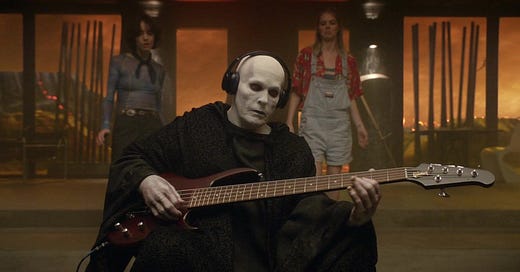As we start our Spooky Season collection, let’s talk about Death (proper noun). Personifying our mortal end is a device as old as storytelling. Check out Iseult Gillespie’s animated telling of the myth of Hades and Persephone, a story that turns the changing of the seasons into a delicious, soapy drama. Talia Miller brings us up to the present, looking at how the myth of Hades and Persephone is retold and reimagined, such as in the musical Hadestown or comic series Lore Olympus.
And just because Patrick Page has a voice to make the underworld quake, here’s a live performance of “Why We Build the Wall” from Hadestown:
Sometimes Death is found moving around our mortal world out of curiosity, or even weariness. Danny at pre-code.com breaks down the 1934 film Death Takes a Holiday, which is part art-house rumination on death, part screwball comedy. Or consider this clip from the 2002 reboot of The Twilight Zone where Jason Alexander plays a burned out Grim Reaper who takes some time off until a Doctor realizes there’s nothing miraculous about an end to dying:
The most iconic image of Death comes from Ingmar Bergman’s The Seventh Seal. Anna from Film Grimoire considers him the ultimate cinematic villain: A force who never stops, never tires, and always wins. Jude Leese has a slightly different view, seeing this Death as an amused observer of humanity.
William Sadler discusses creating his take on Death from the Bill & Ted films, which took the highbrow art film reference and filtered it through the sensibility of the titular California rockers. Brandon Ledet weaves it all together, looking at similarities in the moral of both The Seventh Seal and Bill & Ted’s Bogus Journey.
Thomas Thorogood digs deep, asking if the murderous Rube Goldberg set pieces of the Final Destination series could show Death as a conscious, reasoning entity:
Like all cinematic characters, Death is what you make it.
👋 Are you new here?
Inneresting is a weekly newsletter about writing and things that are interesting to writers. Subscribe now to get more Inneresting things sent to your inbox.
Previously on Inneresting…
In case you missed it, in last issue’s most clicked link Rachel Kwon explores the fury generated by needlessly fancy/smart products that can’t even work as intended.
What else is inneresting?
Learn about Dr. Saul Justin Newman, awarded the Ig Nobel Prize for his work disproving studies about “Blue Zones,” areas where people tend to have exceptionally long lives. His work suggests that results in previous studies are based on clerical errors or fraud.
A look behind the song “Monkeys Spinning Monkeys,” and the origin of its use on TikTok.
Vulture’s staff call out 100 influential horror films, creating a timeline of terror.
And that’s what’s inneresting this week!
Inneresting is edited by Chris Csont, with contributions from readers like you and the entire Quote-Unquote team.
Are you enjoying this newsletter?
📧 Forward it to a friend and suggest they check it out.
🔗 Share a link to this post on social media.
🗣 Have ideas for future topics (or just want to say hello)? Reach out to Chris via email at inneresting@johnaugust.com, Mastodon @ccsont@mastodon.art, or Bluesky @ccsont.bsky.social




